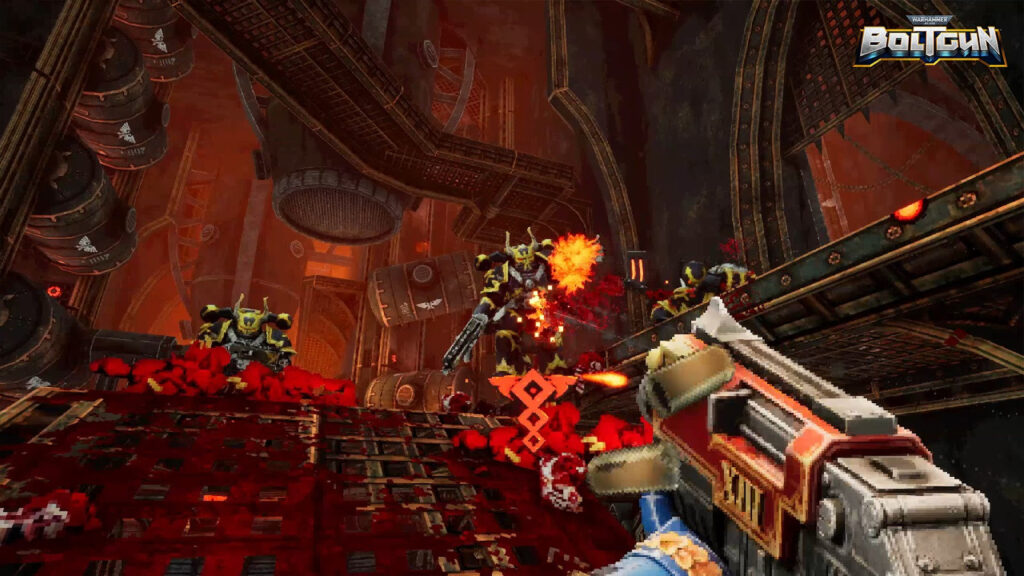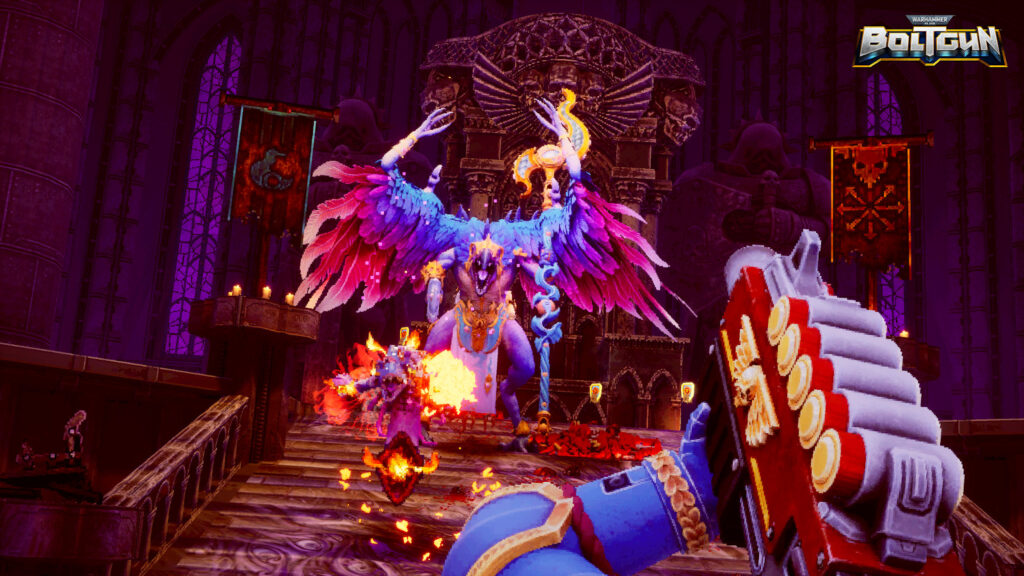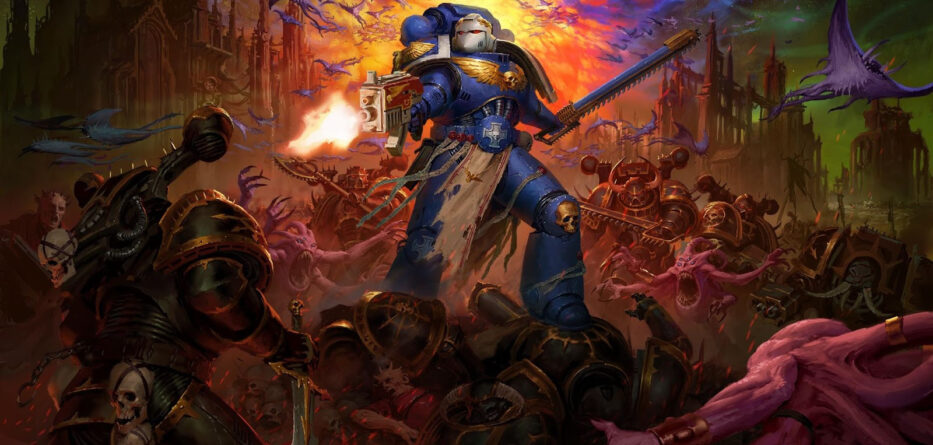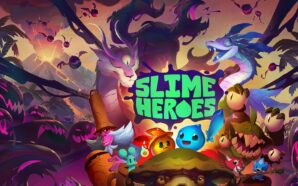Review
Retro Shooters are currently all the rage with many games in the First-Person Shooter (FPS) genre, such as Ultra Kill and Dusk, attempting to recapture the essence of 90s-era shooters. Focus Entertainment and Auroch Digital’s take on the Boomer Shooter genre merges the dark and depressing universe of Warhammer 40k with a bloody FPS roller coaster ride, bringing us Warhammer 40,000: Bolt Gun.
Story
In Warhammer 40,000: Bolt Gun you play as a Space Marine; a mighty Ultra Marine to be precise; brought to the Forge World of Graia by the Inquisition to rip and tear through the armies of Chaos. The story of Bolt Gun is almost non-existent and can be easily ignored much like those in other Boomer Shooters. This is reflected in gameplay trailers; Focus and Auroch know exactly why people are interested in Bolt Gun: it’s a nostalgic throwback to the 90s where gameplay took precedence over storytelling and where a gun was the solution to all of the world’s problems.

The inquisition has ordered your assistance with the cleansing of the Forge World Graia
Gameplay
I have played plenty of fast-paced First-Person Shooters like Doom Eternal and Wolfenstein II: The New Colossus. I have a lot of love for fast-paced FPS action where the need for realism is thrown out the window in pursuit of fast and intense gameplay, and where you’re encouraged to use mobility and the environment to get the drop on the enemy. This approach to gameplay is evident in Bolt Gun. As a Space Marine you are an extension of the Emperor’s fury and, as such, have been blessed by the Emperor himself with mighty weapons such as the old reliable Bolt Gun to do his bidding, and also more out-there weapons like the Vengeance Launcher from 2011’s Space Marine, and of course the almighty Melta Gun.
Guns and movement have incredible feedback and take full advantage of the PlayStation 5’s DualSense controller. The Space Marine lands like a two-tonne weight on the battlefield and the Bolt Gun has a satisfying kickback with every shot. The gameplay feels fantastic as you jump around fighting Chaos spawn. You have access to a charge move that can make mincemeat out of weaker enemies and the almighty Chain Sword makes light work of chopping through Daemons. Enemy variety is another positive of the game; it’s clear the developers have a love for the 40k series as they pull inspiration from the wider Warhammer universe to bring enemies such as the Pink Horrors that, when killed, split into two Blue Horrors; the Chaos Cultists that cower in fear as you approach; and the Chaos Terminators that move slowly around the battlefield, holding massive gatling guns.

Click click boom
Unfortunately, the game isn’t flawless. One of my criticisms of the game is the random difficulty spikes, especially with a recurring boss known as the Lord of Change. It is during these fights where interesting enemy encounters and fun level design go out the window. This, coupled with the lack of respawning health pickups makes encounters with the Lord of Change or any other boss feel almost impossible. The Lord of Change is usually situated in an incredibly small arena accompanied by an endless horde of annoying enemies called Ascended Marines that are ostensibly charging Space Marines who make the encounter feel like a never-ending cycle of death after death. I feel that these fights would benefit from some tweaking since the game comes to a screeching halt every time I was faced with one and if it wasn’t for the accessibility option to make yourself invincible, I wouldn’t have gotten as far through the game as I did.

Probably the most annoying mini boss in the game

The Great Unclean one lovingly recreated in the blocky style
The game uses a combination of auto and manual saves but the auto saves aren’t as frequent as I would like, pushing the player to manually save before a challenging encounter lest they be subjected to a continual battle with one of the game’s several difficulty spikes.
Moving the Space Marine can at times feel like moving a massive shopping cart, leading to unfair deaths at the hands of enemies that have the speed and agility that the player could only wish for on normal difficulty.
Graphics
Bolt Gun adopts a pixelated graphical style that produces an aesthetic reminiscent of arcade shooters you would find in any 90s-era arcade. Enemies are beautifully recreated in the blocky art style and your eyes never have any issues in determining what you’re shooting at. You can also adjust the graphics to give the game an even more retro-styled look should you wish. Each level oozes with the typical 40k architecture with massive factories dedicated to the Machine God, blood-soaked citadels and desert landscapes. However, the level design only gets really interesting once you go within the warp to fight your enemies which doesn’t happen too often. Outside of that, the environments can get a little samey, although this doesn’t take away from the addictive gameplay.
Sound design
Bolt Gun’s sound design is any Warhammer fan’s wet dream. The titular Bolt Gun sounds like a miniaturised minigun as it carves through flesh; cultists scream in pain as you rip them apart with your Chainsword; and the sound of the Space Marine’s feet pounding through hallways has a great sense of presence. The game’s music on the other hand is a little lacklustre. Sure, it has all the gothic stylings of any Warhammer game, but it feels a little drowned out by all the gunfire and even when I could hear it, it never felt memorable.
Conclusion
Should you play it? Yes
Why… Bolt Gun is an awesome blast from the past that takes the world of Warhammer and compresses it down into an 8-bit stylised gore fest: fast, fun and lovingly detailed. Bolt Gun is a love letter to all things Warhammer.
But… the random difficulty spikes, unfair encounter design, and infrequency of autosaves can make the game feel like a slog.
Reviewed on PlayStation 5
Developer: Auroch Digital
Publisher: Focus Entertainment
Playable on: Xbox Series X/S, PlayStation 4/5, Switch, PC
Released: 23rd March 2023








